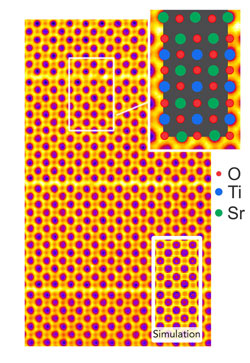
Molecular Foundry users from Penn State University and Cornell University have worked with staff to describe the first atomic scale evidence for strain-induced ferroelectricity in a layered oxide. Pushing the limits of electron microscopy into the tens of picometer scale, the team has developed the ability to see at this subatomic level, which is crucial for designing new materials with unprecedented properties.
Designing new materials with potentially useful properties requires the close collaboration of theory, synthesis and characterization. The study brought together electron microscopy and density functional theory on a 5 to 10 picometer length scale to show why layer oxides are such good tunable dielectrics. The team showed that many polar phases with similar energies compete in this material on the atomic scale, just as theory predicted, which gives it large tunability under a voltage.
In the case of one type of layered oxide, strontium titanate, there is a large dielectric response, which is the ability to store large amounts of energy, as in a capacitor. Cell phones have many dielectric components that are very small and have to hold a charge. As cell phones transition from 4G networks to 5G, which means they are processing at 5 billion cycles per second, better materials that respond at higher frequencies are crucial. Strontium titanate is a material that is definitely superior to current materials.

